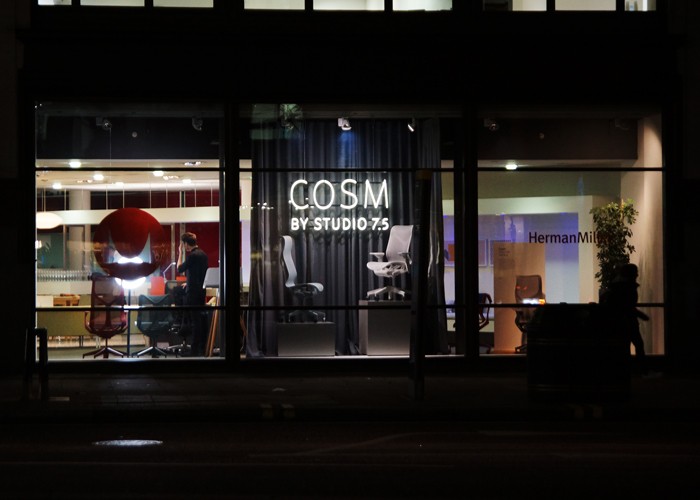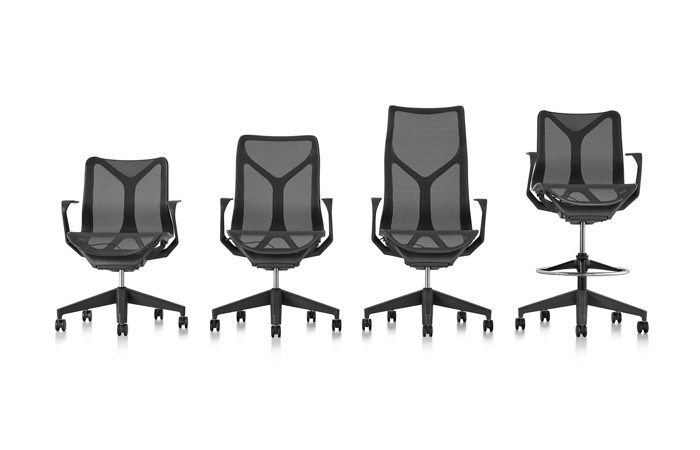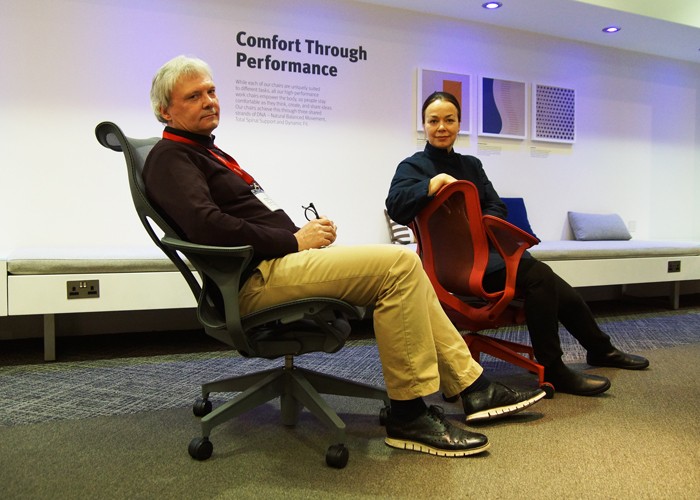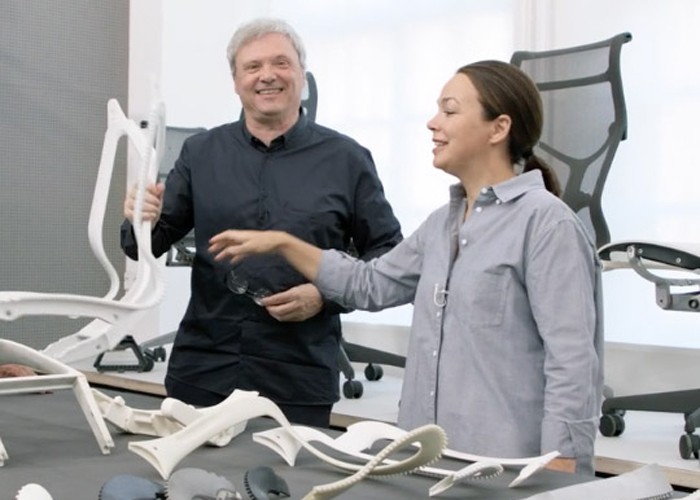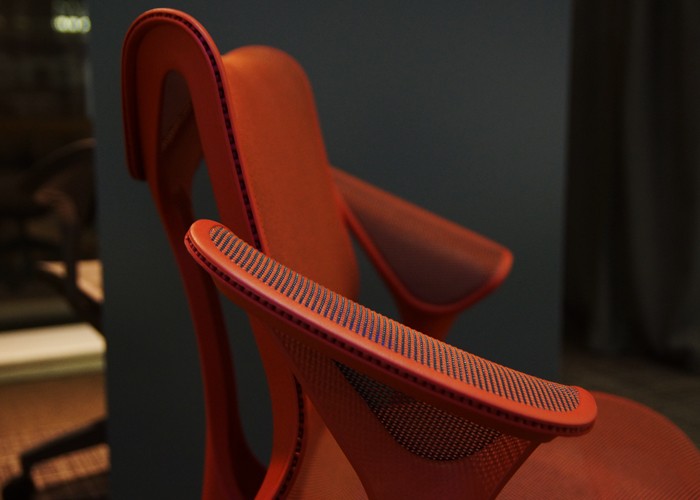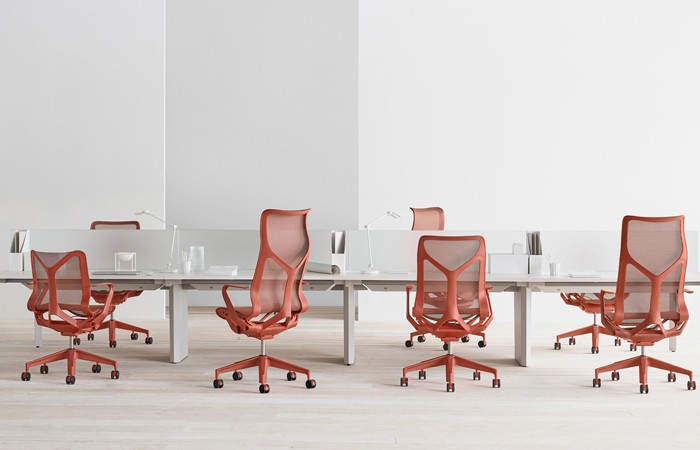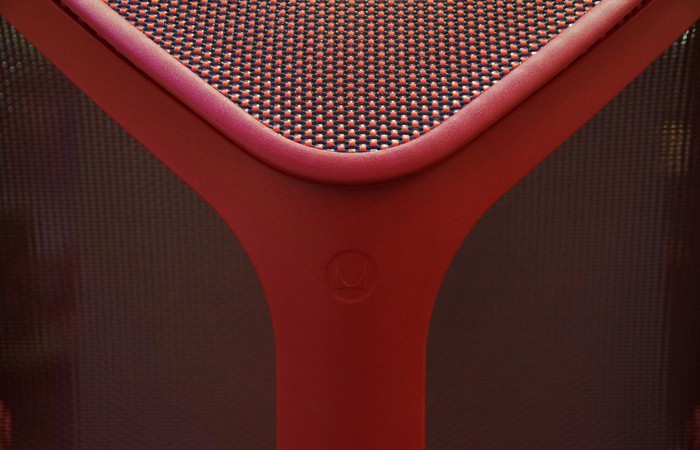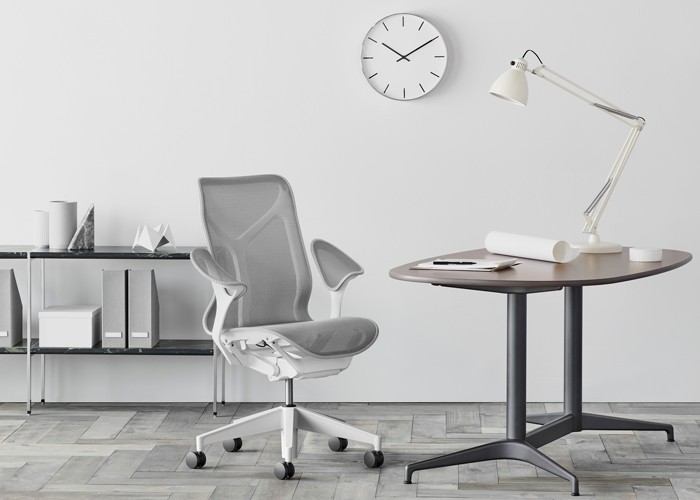Q&A: Studio 7.5 design Cosm for Herman Miller
In January Herman Miller launched Cosm, designed by Berlin-based Studio 7.5. Cosm is Herman Miller’s first task chair with an automatic tilt. It also has the industry’s first suspension armrest. Initially revealed in Milan during Salone Del Mobile 2018, the chair will be available for order worldwide later this summer. The revolutionary design demonstrates that, even as the family of brands adds product breadth, Herman Miller continues to offer depth.
To experience Cosm is—as Studio 7.5 says—to forget gravity. And now people can have that comfort and support no matter how many settings they sit in throughout the day.
As more organizations move toward shared workplaces and workpoints, and people enjoy the freedom to choose the setting based on the work they need to do, one thing hasn’t changed: the need for ergonomic support. Cosm offers exactly this consistency, providing unparalleled comfort and performance, making it not only great for individuals, but also the ultimate shared chair. Cosm rapidly adjusts to whomever is sitting in it using its hidden “engine,” the Auto-Harmonic Tilt™—a culmination of two decades of design research and engineering that further deepened Herman Miller’s understanding of how people sit and work.
Design Insider was invited to meet speak with Burkhard Schmitz and Carola Zwick in detail about their design process and the creation of Cosm.
Could you begin by introducing yourselves?
Burkhard Schmitz: 7.5 is a design team, it’s very much like a family arrangement where we all participate in all roles.
We started after the Berlin wall came down, we said, “This is the time. We have to go back.”
Carola Zwick: The rents were insane. The idea came to have a big truck and go from client to client. At that time with our normal driver’s licenses you were allowed to drive trucks up to 7.5 tons. That defined the size of our studio. Hence the name.
Would you be able to tell me about your starting point for Cosm?
BS: The starting point was the very first successful brief we ever got, the Mirra Chair. For Cosm there was no brief.
BS: We were on the road presenting the Mirra Chair. It was almost like a band, right? There’s new material in this spare time between concerts. I thought that our engineer Roland was considering a cardinal sin when he made a chair out of pieces from Mirra and from Setu. If you like herring and also like chocolate, I don’t think that herring chocolate is a great combination.
CZ: When we saw that, we were really shocked.
BS: Until we sat in it and we said, “Man, if the competition had this, we would have a problem.” It combined the torsional flex that Mirra allows you with the central spine and the continued surface of Setu in one chair and the concept of a self-adjusting tilt.
Talk me through the design for the Cosm chair, please?
CZ: The working title was flying carpet and somehow Cosm as a name resembles this idea of being suspended in midair.
BS: It sounds like a contradiction, but there’s a saying that comfort is the absence of awareness. All the adulation, the forms and especially those curves are there so that you don’t feel the frame. We knew we wanted to try to have suspension arms.
CZ: One reason for these 4D arms is that you can scoot them back so that you can get closer to the desk.
The membrane is a really defining detail; tell me more about how you incorporated it into the design?
BS: The way the membrane is attached allows you to see the elements of the frame, they have teeth around the edge detail, so you basically zip it up.
CZ: The zipper is a highly industrial detail, but it has an artisanal quality because it looks like a stitching and it helps people to read the construction.
BS: If you make a chair so transparent you can’t tuck anything away, you see through the whole thing. There’s no part on the chair that we are ashamed to show.
What did you feel was the key problem to solve?
BS: The self-adjusting tilt for a long time was like a stone in your shoe. With the American colleagues we worked together to get rid of the tolerances, which they love to build in to things.
CZ: There are colliding interests and engineering principles that we faced on other programs as well. But I think that that’s one of the beauties, evolution is a much more powerful concept.
What was the most enjoyable aspect of the project?
CZ: Once it’s finished and it’s out there. It’s always nice to get this feedback that people like it and then suddenly it doesn’t feel like you’re driving on the wrong side of the street. We worked eight years on this, and you are not allowed to talk to people outside.
Were there any environmental considerations?
BS: It was the first product in Germany to receive the ecology award.
CZ: We have this mantra of every molecule counts. So be as clever as possible with the geometry because that then saves material. Obviously, we are into polymers, we like plastic. And that has a bad reputation, but that’s for the one-time usage. We think it’s much too precious to waste it on those applications. It’s a great material if you understand the unique properties.
BS: We also tried to use as little different plastics as possible. To our knowledge, this is the very first chair where the spine and the frame, are made of the same material. If you’ve ever seen the Herman Miller test lab, I mean they call it the land of broken dreams, and for a reason. It’s crazy what they do to chairs and without naming any other brands, it’s doubtful that many of them would survive those tests.
What has the experience been like working with Herman Miller?
CZ: Working with Herman Miller is like dancing with a Dutch girl.
BS: First, it takes forever for her to actually get up. And then you learn about the shoes. Wooden shoes.
CZ: Then she doesn’t want to stop dancing. No, I think it’ a very good working relationship and it’s a push pull in both directions and that is not always fun, but I think we challenge each other.
Last question. What’s next?
CZ: Oh, we can’t talk about it.
AWB: I knew you were going to say that.
CZ: I think the only thing we could say is material innovation. We’ve tried to come up with constructions and methods to create materials that are more sustainable and also where we are trying to get to a better weight performance ratio and strength to weight ratio for new materials.
BS: It’s a crusade that we’re on and we’re not sure whether we are successful, but at least we try.
Contact Herman Miller
Contact Studio 7.5





